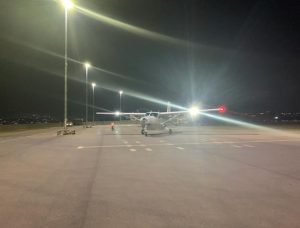What is NVIS Lighting?
NVIS Basics
Night Vision Imaging System (NVIS) requires more than just goggles. You have to have compatible lighting.
(more on compatible vs compliant later)
Goggles operate by multiplying faint light sources and presenting them as images on little screens in front of
your eyes
In an aircraft, the night cockpit has many light sources – displays, lit instrument lights, status lights, fire
lights, flood lights and even iPad screens. In that goggles operate by multiplying available light, these night
cockpit light sources compete with those fainter outside light sources and can dramatically degrade goggle
performance which, in turn, can keep you from seeing what’s outside.
Fortunately, there is a good solution.
Goggles see a slightly different spectrum (higher) than the human eye. The goggle manufacturers improve
this spectrum difference by putting an internal filter into the goggles that further separates what the eye sees
and what the goggles see. (This internal filter determines Class A, B or C goggles)
Pilots fasten their goggles onto a helmet or mount on their head so that the goggles are suspended directly
in front of their eyes. There is a short distance between the back of the goggles and the eye (called the relief
distance). This relief distance allows the pilot to look under and around the goggles at his cockpit
instruments and other lights. He looks straight ahead through the goggles when he wants to see what’s
outside..
Now, the challenge becomes to make all those cockpit lights essentially invisible to the goggles so that
goggles can see those much fainter outside lights without having their performance degraded by competing
cockpit lights. This is the art of NVIS lighting modification.
Professionally modified cockpit lighting should be an even, soft shade of green for status and most
annunciation lights (green is the best color for human eye response and many people find the NVIS cockpit
lighting better than the original).
Caution lights can be their correct yellow color with the most goggles. Red warning lights and the reds in full
color displays are challenging. Goggles “see” down into the red spectrum. Thus, red fire lights are made an
“orangish” red called NVIS Red which is just below the goggle response spectrum. Full color displays may
actually be modified to the compatible standard rather then the compliant standard to allow true red. This
small amount usually does not affect the goggles.
Everything in the cockpit should be clearly lit with no shadows Most important, every single light source
should be addressed.
The goal is to minimize the pilot “heads down” in-the-cockpit time to the absolute minimum during critical
night operations.
Exterior Lighting
Exterior lighting also needs to be made compatible with goggles. It is probably obvious that the wingman in a
formation flight looks at his leader’s exterior lights through the goggles and thus needs to see compatible or
“NVIS friendly” light.
It may be less obvious that a lone aircraft operating in hostile airspace needs NVIS exterior lighting. Here the
pilot likely turns off his visible FAA required red, green and white position lights so that he doesn’t get shot
at. Now, he needs to be visible to other NVIS aircraft operating without visible lights so that he doesn’t get
run over. In short, he needs covert lighting, which is called infrared (IR) lighting, that can be seen by other
goggle operators, but not by the unaided human eye. Direction and intensity of the IR sources can be
controlled so that NVIS equipped adversaries are unlikely to see you.
Dual mode Anti-Collision lights can be added if further distance of detection is needed. Those flashes can be
coded if there is a need to quickly tell aircraft apart in that environment. ( I.e two flashes can mean # 2 Acft, 3
flashes #3,’ etc)
Compatible vs Compliant lighting. You hear these two terms used all the time. Many times interchangeably.
There is a difference. Compliant means that it complies to the standards of MIL STD 3009, the current NVIS
bible. Compatible is a more general term and can mean that it just “works OK” with the goggles. Many times
compatible is fine and may be what is needed. A MIL STD 3009 cockpit visual acuity test can confirm.
NVIS Friendly is a term used to talk about exterior lights. Your wingman is looking at you through his
goggles. He needs to see your lights. But, most exterior lights contain so much IR energy that his goggles
“bloom” or “halo”, which means that they degrade and are so bright that they obsure key visual references.
The solution is to remove most, but not all, IR energy and make them “NVIS friendly”.
Click below to view Technical Briefing.

ATI has spent more than a decade engineering and certifying custom light solutions for multiple military platforms. ATI has provided Night Vision training to members of all major defense suppliers as well as Foreign and Domestic military personnel and organizations. The ATI Engineering organization is considered an industry leader in the development of custom Night Vision solutions.
